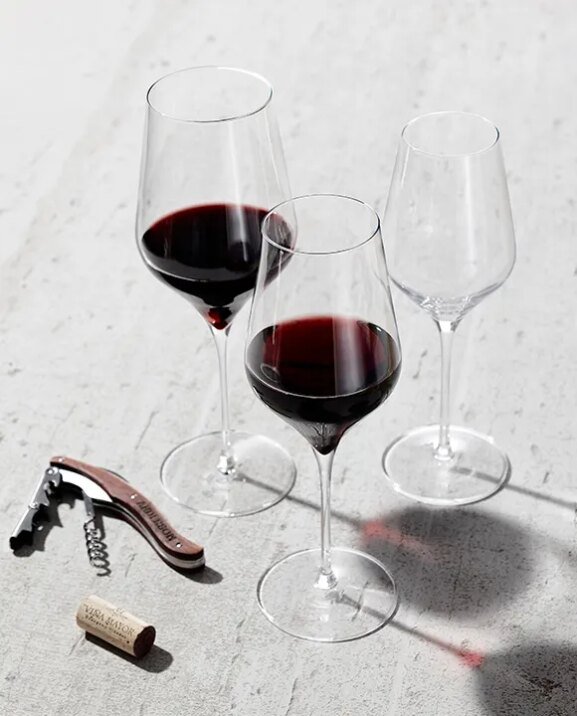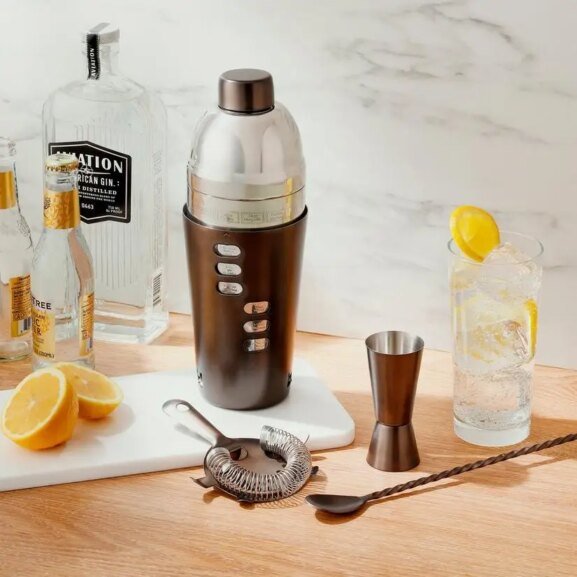These Forest-Forward Spirits Capture the Allure of the Woods
“We are always drawn to the forest, to nature,” says Caitlin Bartlemay, master distiller at Hood River, Oregon’s Clear Creek distillery. “Even though we don’t always get to spend time outdoors.”
The allure of the woods has prompted some distillers to try to capture the bracing notes of evergreen trees and mushroom-y forest floors in a bottle. And the end result is yet another example of terroir, making it easy to imagine a thicket of towering trees or an unspoiled mountain peak just beyond the horizon of your glass.
Perhaps the OG of this outdoorsy category is St. George’s Terroir Gin, inspired by Mount Tamalpais near the Alameda, California, distillery. Master Distiller Lance Winters describes it as akin to “drinking a martini in a pine forest.” Given the abundance of wooded areas in Northern California and the Pacific Northwest, it’s unsurprising that so many distilleries in the area pinpoint the forest as a muse.
But forests—and bottles inspired by their verdant beauty—span the world. Botanicals found in Germany’s Black Forest inform Monkey 47 gin; Glenmorangie’s “A Tale of the Forest” kilns barley with birch bark and heather to evoke “woodland botanicals” in a single malt Scotch; rums and cachaças frequently nod to lush tropical rainforests; The Hakushu paid homage to the beauty of untouched nature with a Japanese Forest Bittersweet Edition whisky bottling.
Here are the stories of five bottles (and some tips on what to with them) that will have you dreaming of sipping beneath a forest canopy.
Astraea Forest Gin
Similar to wine grapes, botanicals can express differently depending on where they are grown, says Danielle Leavell, founder and master distiller of Seattle’s Astraea Spirits. For that reason, “forest” isn’t a monolith.
“The forest here will be different from the forest where I grew up in Illinois, versus upstate New York or Vermont,” driven by differences in temperature or rainfall she explains. But those geographic differences “allow people to go on a journey and imagine what that landscape is.”
In addition to a classic London Dry, Astraea makes a trio of terroir-specific gins: Meadow, Ocean and a bright, bracing Forest expression.
“We specifically use a fresh balsam fir and spruce,” for the Forest Gin, Leavell explains. “I want to work with them when they are at their peak freshness, when they are the most hydrated. That makes for a clean, lush, verdant, slightly sweet expression.” Added to the classic botanicals used in the London Dry base (lemon and orange peel, coriander, angelica), the end result is “a forest floor base note” that speaks to the wet climate of the Pacific Northwest, along with plenty of bright citrus.
She also flags the importance of looking after the landscape that provides for the gin.
“We’re mindful of how much we take from the forest,” she adds, citing the risk of adding to forest fire hazards and other environmental concerns. “It’s tied to the wellness of the forest and how much we can sustainably take.”
Try It: In a dry martini, with olives
BroVo Uncharted Rhapsody American Forest Liqueur
A collaboration with Chicago bar pros Micah Melton (The Aviary) and Chad Hauge (Longman & Eagle), this complex, high-proof “alpine liqueur” was developed in the shadow of a Chartreuse shortage. As a result, it shares some similarities with the centuries-old French liqueur, yet has its own personality, opening with bold fennel and anise, and finishing long and warming with fresh tarragon and spearmint tingle.
“People talk about Chartreuse having 100-plus ingredients,” says Mhairi Voelsgen, BroVo’s cofounder and CEO. “We have 50-plus in this one.”
The herbal liqueur is in keeping with the Woodinville, Washington-based craft distillery, which has built a business around interpreting traditional European spirits (notably, amaro and vermouth) with “a North American vocabulary,” often with the assistance of noted bartenders from around the country.
While she’s as secretive about the Uncharted formula as the Carthusian monks famously are about their well-guarded formula, Voelsgen hints that Douglas fir and hops may be included: “We wanted to make it distinctly Northwest and add some elements from our backyard that are grown and consumed here.”
As a former camp counselor who spent days among the tall fir trees, her perception of a forest-driven spirit is one that “is fresh and green and alive,” she says. Compared to amaro, which often features dark, brooding flavors, Uncharted has a brighter tone: “This, to me, is like you’re walking in the woods and there are birds chirping.”
Verte Chaud
Adapted from Mhairi Voelsgen, BroVo
Typically, this warming drink, which translates as “hot green,” is made with Green Chartreuse. This variation uses an American-made herbal liqueur, plus Mexican hot chocolate for a little extra kick.
Ingredients
- 1 ½ ounces BroVo Uncharted Rhapsody American Forest Liqueur
- 5 ounces hot chocolate (Voelsgen recommends Abuelita Mexican Style Instant Hot Chocolate Mix and whole milk)
- Whipped cream, for garnish (optional)
Instructions
Stir together in a footed Irish whiskey glass or mug. Top with whipped cream, if desired.
Michelberger Forest Kräuterlikör
Remember the dark folk tales of the Brothers Grimm? Note the wolf on the label of this bitter liqueur, the nemesis of Little Red Riding Hood, who met a wolf while going through a German forest to visit her grandmother.
Technically, this spiced liqueur is considered a Kräuterlikör, an amaro-like spirit specific to Germany (another you may be more familiar with: Jägermeister). Intended as an invigorating ode to Germany’s forests, the liqueur is flavored with gentian root (a bittering agent), lemon balm, cinnamon bark and vanilla, and rested in earthenware pots to let the flavors meld.
It’s a modern-day interpretation of a 19th-century schnapps recipe, which would have been consumed while hunting in the woods, says Eunice Choi, spirits portfolio manager for T. Edward Wine & Spirits, which imports the bottling. Interestingly, it was revived by the entrepreneurial owners of a Berlin hotel and Preussische Spirituosen Manufaktur.
While the liqueur isn’t actually flavored with botanicals sourced from the Black Forest, its brisk Alpine flavors are meant to evoke the spirit of the woods. Most people will likely never nibble the needles of a German spruce tree, she says. “But you can get that expression in a forest-inspired liqueur.”
That translates as a relatively warm and nutty spirit, with a pronounced baking spice note and bitter edge, lifted by a hint of lemon balm. “It’s not 100% brooding,” Choi reassures.
Try It: In a Manhattan variation, mixed with rye whiskey and sweet vermouth

Clear Creek Douglas Fir Brandy
A video on Clear Creek Distillery’s Instagram page shows a small group of workers swiftly clipping the spring-green tips from Douglas fir trees this past June, as birds call softly in the background.
It’s a tradition inspired by Eau de Vie de Bourgeons de Sapin, an Alsatian eau de vie that Clear Creek’s late founder Steve McCarthy enjoyed while in Europe. Today, it’s an annual tradition for employees at the Hood River, Oregon, distillery to head out and gather “Doug fir” buds each spring.
“It’s only a five-day window,” explains Head Distiller Caitlin Bartlemay. Working with the Hood River County Forestry Department, it’s a race against the clock to pick enough buds to steep a year’s worth of brandy. “That afternoon, they’re weighed and go immediately into the brandy. They’re very fragile.”
The end result is a vibrant, aromatic brandy with a remarkable pale-green hue that recalls those freshly clipped fir buds.
Made in limited quantities, the brandy has become a bartender favorite for adding delicate floral and pine complexity to drinks.
A more adventurous cocktail culture that embraces flavors from savory to bitter has helped drive interest in woodsy spirits, Bartlemay observes. In fact, it helps that trees and forests provide a familiar reference point: “People are willing to experiment with something that tastes like pine needles or trees,” she says. One way she describes the flavor: “It tastes like going camping.”
Try It: In an Apres-ski-worthy sidecar
Freeland Forest Gin
Molly Troupe, master distiller for Portland, Oregon-based Freeland Spirits, didn’t have to look far for inspiration for this newcomer to the Freeland line of spirits. “It was inspired by Forest Park, about five miles from the distillery,” she explains. One of the nation’s largest urban parks, “it’s always been a spot for us, if we have time and need a little inspiration, to go for a walk.” It doesn’t hurt that foraging is permitted.
“Juniper already has a forest feel,” Troupe says of the decision to home in on gin, as opposed to any other spirit. Juniper berries, a required ingredient in gin, are often described as having pine-like characteristics.
While some of the ingredients are found beneath the canopy of the forest, others were selected to suggest the experience of a walk in the woods. Chanterelle mushrooms add earthiness, but also a vanilla note; blueberry-like salal berries create “a light jammy quality,” while nettle contributes vibrant green tones.
“It was about trying to figure out what story the ingredients were trying to tell,” Troupe recalls. “A lot of the ingredients turned out to be very playful; it’s like a walk through the woods—but a daylight walk, where the light is disappearing.
Forest Negroni
Adapted from Freeland Spirits
Instead of the typical scarlet Negroni, try this bracing, citrusy variation, which lets the woodsy botanicals in the gin shine. If an edible fern is unavailable, substitute a twist of grapefruit, lemon or lime peel.
Ingredients
- 1 ½ ounces Freeland Forest Gin
- ¾ ounces Luxardo Bitter Bianco
- 1 ounces bianco vermouth
- 2–3 dashes grapefruit bitters
- Edible fern, for garnish
Instructions
Stir all ingredients with ice. Strain into a rocks glass, over a large piece of ice. Garnish with edible fern.
This article originally appeared in the November 2024 issue of Wine Enthusiast magazine. Like what you see? Get access to the whole issue by subscribing here today.
More Coverage of Botanical Spirits

In the Shop
Sip with Elegance
Our selection of barware glasses and personalized sets are the perfect way to enjoy that special bottle and end your night on a good note.
Published: September 25, 2024
Like what you’re reading? Learn more about:

